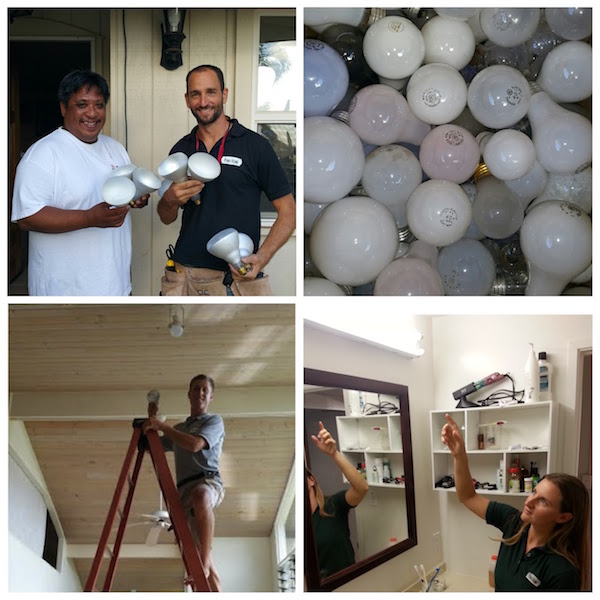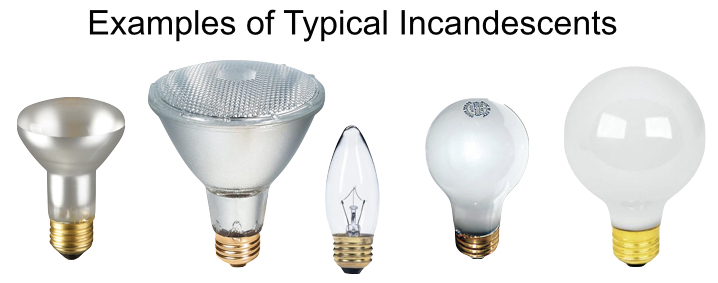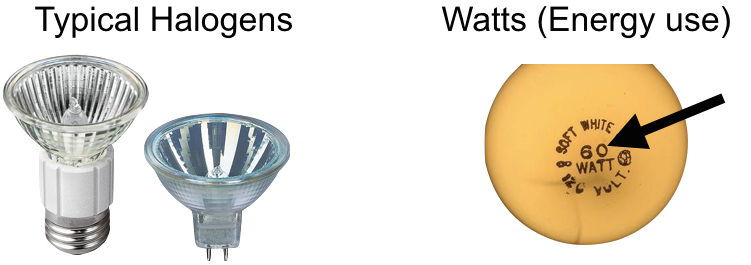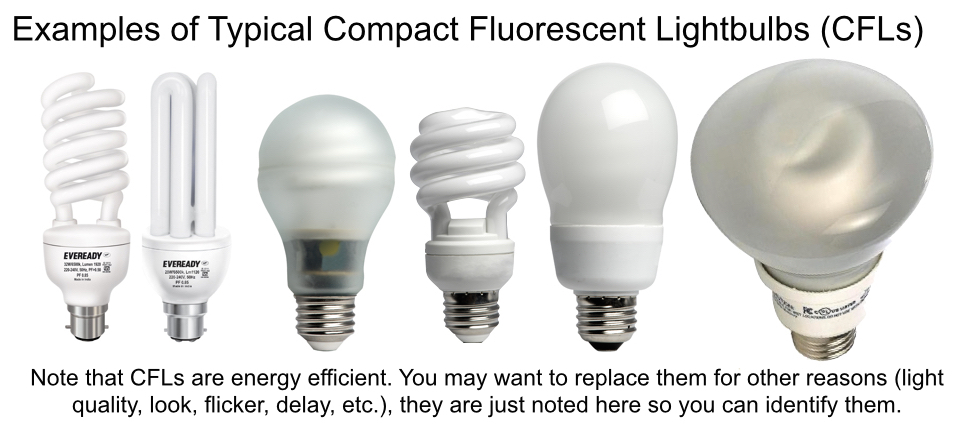
Lighting in your home can account for 15-20% of the total electricity your home consumes. Making some minor adjustments to your lighting can have a big impact on your electric bill, your carbon footprint, and yes, your happiness!
Getting started – Do I need a lighting retrofit?
You’ll want to get started by identifying the lighting you have in your home, and you’ll be looking to replace any incandescents and halogens. They come in a lot of different shapes and sizes (see below), but you can spot them because they tend to get very hot when they’re on, and are usually very fragile/lightweight. In addition, incandescents may have visible filament threads. The real indicator is to look for the wattage (the energy the bulb uses), which is often indicated on the bulb either on the top or on the base. If it’s anywhere from 25 watts and up, odds are, you’ve got an incandescent or a halogen that could be replaced to save you 80-90% on your electricity used by the light.


 Compact fluorescent lights (CFLs) are the “squiggly” bulbs you may have seen or used (pictured just above). While CFLs do save energy, they have a number of challenges. The light takes a while to warm up to full power, has a flickering element that you can witness on most CFLs, doesn’t dim well, and the bulbs contain mercury–a highly toxic element that simply doesn’t belong in your home. Our advice on CFLs is to just skip them and go straight to LEDs, but if you have them in your home, you may wish to replace them with LEDs anyway, to improve light quality and remove mercury from your home. LEDs may cost a buck or three more per lamp, but they are far superior.
Compact fluorescent lights (CFLs) are the “squiggly” bulbs you may have seen or used (pictured just above). While CFLs do save energy, they have a number of challenges. The light takes a while to warm up to full power, has a flickering element that you can witness on most CFLs, doesn’t dim well, and the bulbs contain mercury–a highly toxic element that simply doesn’t belong in your home. Our advice on CFLs is to just skip them and go straight to LEDs, but if you have them in your home, you may wish to replace them with LEDs anyway, to improve light quality and remove mercury from your home. LEDs may cost a buck or three more per lamp, but they are far superior.
So if you have incandescents, halogens, or CFLs and want to replace them, read on (or skip straight to the bottom to get us to give you an estimate!).
Benefits and Financial Payback of LEDs
Light Emitting Diode (LED) lights are bright, have a great color rendering index, are usually dimmable (it’ll say on the box), and last 25,000 hours of operation or more. Compared to a CFL (~1200 hours) or an incandescent (~800 hours), that means that you’ll likely never have to change your lights again if you go LED.
LEDs have come a long way in the last few years. Ten years ago, the technology was relatively new, meaning the lamps and bulbs were incredibly expensive, and not quite ready for prime time. The main problems with the LEDs of the time were color, brightness, dimmability, and price. All that has changed, and LEDs are taking over the lighting market more every day. More on that in a moment.
The financial payoff (payback period / ROI) of an LED is beyond question (take a look at that link for a calculation). LEDs may simply be the best investment you can make, period, especially here in Hawaii, where electricity is expensive. Compare an LED to solar energy, where the payback period may be 2-7 years, and you’ll understand that there is simply no comparison (don’t get us wrong–solar is good, too…just takes a lot longer to pay for itself than energy efficiency work, including LEDs).
Light Spectrum and color/temperature
Light color is measured in a scale called “Kelvin” or “K”. 2200K to 3000K color spectrums tend to be the “warmer” or “redder” lighting that you’re probably most used to in indoor settings. 4100K is fluorescent tube lighting, typically, and 5000K and above are typically “bluer” and a little more harsh, thus they are used primarily for outdoor and security purposes. If you inspect a lightbulb package at the store, you’ll see somewhere on it “2700K” or something like that. Here’s a graphic:

Modern LEDs come in all these colors and more–down to 2200 for the really reddish lighting that might characterize “mood” lighting in dim restaurants. You’ll just want to identify the main use for the light in whatever fixture you’re working on, and buy appropriately.
Getting the LEDs you need
We offer a full lighting audit and LED retrofit, of course, but even if you don’t hire us, we’d still like to see you get a full set of LEDs for your home. So if you’re the DIY type, here’s an LED lighting self-audit, where you can identify what you need.
If you’d prefer to have us do the audit and replace your lights right on the spot, we do the audit and then during installation, allow you to sample any light in any fixture before committing to buying it. We sell LEDs at retail price, meaning you usually can’t beat our price going to the store yourself. While we’re there, we might be able to fix a toilet leak, snake your dryer vent, clean your condenser coils, audit your personal care products for known carcinogens, and conduct diagnostics on your other major appliances.
To schedule an audit, call (844) GO-PONO-1 or e-mail info@ponohome.com.
